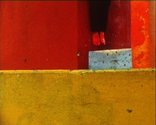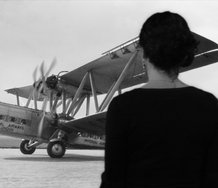Will Gresson – 5 February, 2013
Perhaps the ecstatic dance of the dervish as a primitive representation of the belief of one single truth stands in contradiction to modernity's multiplicity of truths. In this regard the display of the motorized turning dervish dancer dissected into his many different colours might resonate with the beginning of early cinema and its speculative future to come.
Berlin
Marcel Türkowsky and Elise Florenty
A Walking Paradox
15 November -15 December, 2012
The three part exhibition A Walking Paradox from Marcel Türkowsky and Elise Florenty, which recently finished its run at Kinderhook & Caracas in Kreuzberg, Berlin, is a fascinating exploration of myth, place and character. The three film works, divided by a fourth work consisting of a series of coloured ropes and fabrics explore ideas from the artists’ recent travels in Brazil, France, Egypt and Ukraine.
The major work of the three, the film essay A Short Organon For The Hero, clocks in at just under fifteen minutes and was filmed in various neighbourhoods in Rio de Janeiro (Arpoador, Cinelandia Square and Parque Lague). The artists describe the work as follows:
“This short video essay unfolds a story told through the eyes of a parrot. Alone it would have kept in mind the metamorphosis of the modern figure of the anti‐hero Anonymous. The narrative space of the film is deconstructed into areas of colour from which emerge “flashbacks” of fictional and documentary fragments filmed in Rio de Janeiro: scenes reinacting the Brazilian “cinema novo”, the survival of Amerindian sacrifices, filmed documentation of urban occupation evoking the spirit of the “Theatre of the Oppressed”, etc. The colour ‐ all at once, skin, gesture, word, voice ‐structures as much as it breaks. It creates a sort of vanishing punctuation, a punctuation of the memory operating on itself.”
The resulting work is a beautiful, lyrical journey through these multifarious inspirations, and the colour panels which mirror the colours of the other works in the show break up the visuals while never losing the momentum of the narrative. This is largely achieved with a pastiche of texts from a long list of South American authors, read by Sam Ashley, the son of famed American composer Robert Ashley. His soft meandering delivery unfolds the story of the anti-hero and holds the fragmented visuals together. It’s incorporation of images from the Occupy Group in Cinelandia extends the metaphor around the theatre of the oppressed into contemporary socio-political space.
The second major work of the show, Delirium Ambulare, consists of close up footage of the artist’s strolling feet in three different entropic modernist public playground spaces: Flamengo Park in Rio de Janeiro, Maurice Thorez Park in Ivry‐sur‐Seine within suburbs of Paris and Guilliver Park in Donetsk, Ukraine. Each setting is actually an individual short film shot on Super 8, which documents the performance of moving within a space, occupying, leaving, and then reoccupying the strange and starkly modernist areas where each film was shot. The colours are bright and vibrant, which ties the work together with the others in the show aesthetically as well as thematically, and the effect is akin to early short film explorations of movement and repetition.
How To Reach The Front Side, the third work, consists of a dervish dancer spinning around like a child’s spinning top projected through six different coloured nets. The dancer seems to multiply himself by entering into himself, like a Genie of the Lamp or a Russian doll. The work magnetizes a sufi point of view and the suggestion that we only really ever see the “back side,” and that the “front” remains hidden (something akin perhaps to Plato’s cave in mystical Islamic terms). The artists describe the movement of the dancer:
“At first the dancer turns slowly and gains in speed until he reaches a kind of trance, during which he unfolds his arms, the right hand palm towards the sky (the sacred), and the left hand palm directed towards the earth (the profane). The movement of circumambulation follows an anti‐solar direction (counter clockwise). The spiritual ecstasy translates itself into a sensation of flooding and forgetting oneself, culminating the extinction of oneself into the divine presence. How to play again the law of the universe. How to rotate around one’s centre, one’s heart, like the stars orbit the sun. How to unite Heaven and Earth. How to become light.”
Whereas Delirium Ambulare explores the multiplicity of the self into different geographies and A Short Organon For The Hero explores the multiplicity of the self into different historical times, How To Reach The Front Side strives at the heart of a sense of self, and it’s lofty themes have as much of a dislocating resonance as they do a connecting one. The work’s simplicity gives it’s visual effect power though lands less of a psychological punch than the longer film works. Its position high up in the gallery above a door near the entrance has the same effect.
Perhaps the ecstatic dance of the dervish as a primitive representation of the belief of one single truth stands in contradiction to modernity’s multiplicity of truths. In this regard the display of the motorized turning dervish dancer dissected into his many different colours might resonate with the beginning of early cinema and its speculative future to come.
The fourth work in the show, What Do You Call It In Your Language?, is an unidentified object. Two pieces of red and gold fabric are sewn together with no distinctive design or symbol. It is neither a signaling device nor a decoration. While, it does not point out a specific territory, it has the seemingly contradictory affect of dividing up the territory. The spectator is witnessing an art object without any myth hanging in the space resisting towards any symbolic representation, signaling and identification.
What is immediately striking about the show as a whole is how carefully considered it seems, and how well the works complement each other within the confines of the small space. This consistency both aesthetically and within the wider narrative arc of the show as a whole made it a stand out for 2012.
(My thanks to the artists for their additional texts and input).
Will Gresson









 Two Rooms presents a program of residencies and projects
Two Rooms presents a program of residencies and projects Advertising in this column
Advertising in this column



This Discussion has 0 comments.
Comment
Participate
Register to Participate.
Sign in
Sign in to an existing account.